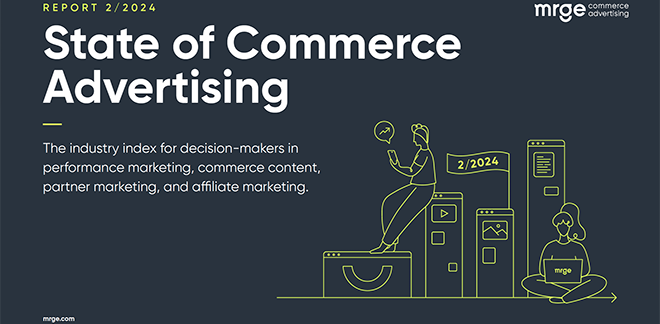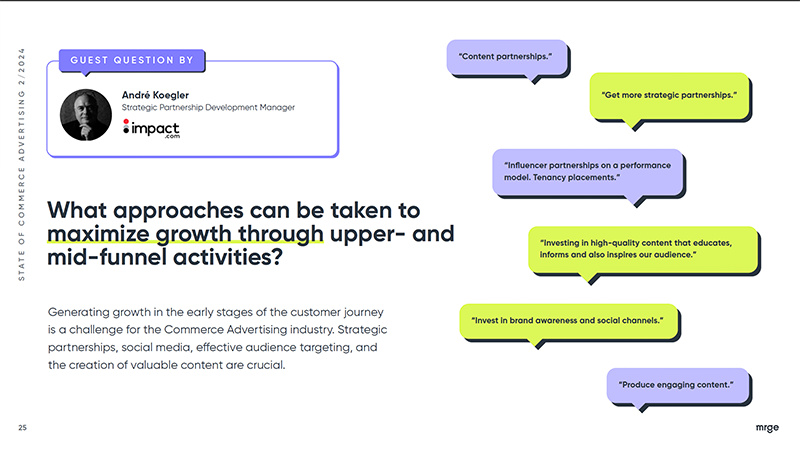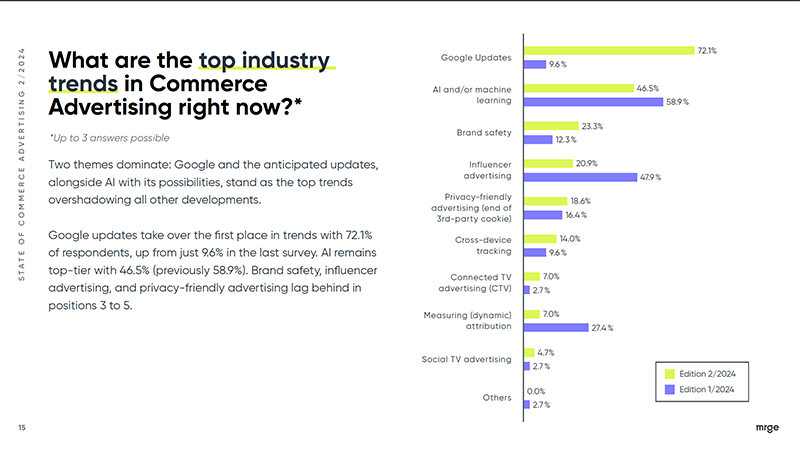
AI is revolutionizing commerce advertising with a 32% revenue increase, according to recent data from mrge’s State of Commerce Advertising Report. We spoke with Felix Witte, General Manager and SVP Publishers & Advertisers to dive into the details.
AI is a crucial growth driver across various aspects of commerce advertising, from content creation to targeting and personalization, according to mrge’s latest State of Commerce Advertising Report.
To learn more about the transformative role of AI in commerce advertising, we chatted with Felix Witte, General Manager and SVP Publishers & Advertisers at mrge. He gave us an in-depth look at the report, showcasing specific examples of revenue increases and operational improvements.
In our conversation, Witte also addressed the challenges posed by Google’s anticipated updates, which are expected to significantly impact content quality and data protection. Transparency is also a crucial concern for the industry, with 94.4% of respondents citing so.
Dig into the Q&A for a comprehensive view of the current and future state of commerce advertising backed by data and insights from the report.
AI as a Revenue Driver
 Lynne d Johnson: The report highlights AI as a significant growth driver. Can you provide specific examples or case studies where AI has substantially increased revenue for commerce advertisers?
Lynne d Johnson: The report highlights AI as a significant growth driver. Can you provide specific examples or case studies where AI has substantially increased revenue for commerce advertisers?
Felix Witte: AI is extensively being used in managing product listings on search engines. Tools like GPT-4 and Jasper.ai can generate product descriptions, specifications, and listings automatically. By inputting basic product information, AI can produce detailed, SEO-friendly descriptions that save time and maintain consistency for publishers. When looking at the advertiser side, we noticed that AI is being employed across the whole value chain.
For example, a large sports apparel company is using AI and machine learning to analyze customer data and predict future purchasing behaviors. They use these insights to tailor their marketing efforts more effectively.
A large beverage company utilizes AI-driven analytics and machine learning to analyze social media interactions and customer feedback. This allows them to create more targeted and personalized ad campaigns.
A leading online publisher uses AI to create a dynamic content recommendation engine that adapts to user preferences in real time. They also employ AI to optimize their native advertising, ensuring that ads are more relevant to readers.
At mrge, we use AI to optimize partner program selection as well as using automated bidding to ensure the best traffic is directed to our partners.
The AI market is expected to grow from $184.00 billion in 2024 to $826.7 billion in 2030. We believe a large part of this growth will be driven by the commercial and operational upsides that AI offers.

AI’s Expected Impact: AI is viewed as having high potential in advanced targeting and personalization, content creation, and campaign optimization.
Navigating Google Updates
LdJ: The anticipated Google updates are a major concern for the industry. What specific changes are expected, and how should advertisers and publishers prepare to mitigate potential negative impacts?
FW: In the second quarter of 2024, Google severely penalized performance marketing outside its walled gardens. Content white-label solutions have been effectively eliminated. Content sites have lost one of their key growth drivers (commerce content on their sites) and are now struggling to determine new growth strategies. AI regulation has been tightened to favor the classic Google search, which coincidentally started experimenting with the inclusion of coupon and discount codes. Industry experts believe Google will continue to become more restrictive regarding the types of traffic, specifically:
- Content quality: Emphasis on original, high-quality content over thin, low-quality content.
- EAT (Expertise, Authoritativeness, Trustworthiness): Continued focus on E-A-T criteria, particularly for Your Money or Your Life (YMYL) sites, which include many affiliate marketing websites.
- Page experience: Incorporation of Core Web Vitals into ranking signals, affecting how pages are assessed based on user experience metrics.
- Product review: Enhanced algorithms to evaluate the depth, quality, and authenticity of product reviews, favoring comprehensive, insightful content.
Additionally, past Google changes were focused on English-speaking countries only. We expect that Google will extend its policy to all languages.
Google Updates Impact: Emphasis on high-quality content and strict data protection rules.
Enhancing Transparency
LdJ: With 94.4% of respondents highlighting the importance of transparency, what measures are being implemented to enhance transparency within the industry, particularly in ad placements and revenue reporting? What steps is mrge taking to improve transparency in Commerce Advertising transactions and reporting?
FW: To improve transparency and efficiency at scale, we have implemented direct integrations with affiliate networks. These integrations allow for seamless data exchange and real-time tracking, ensuring that all parties have immediate access to performance metrics and detailed insights. This level of transparency helps in building trust between advertisers and affiliates, as it provides a clear view of traffic sources, conversion rates, and overall campaign effectiveness.
Our approach also includes maintaining a high level of responsiveness to advertiser requests. We understand that timely and effective communication is crucial for successful campaign management. By prioritizing advertiser needs and swiftly addressing their inquiries, we ensure that their campaigns run smoothly and any issues are resolved promptly. This proactive stance not only improves campaign performance but also fosters long-term partnerships with our clients.
Additionally, we employ proactive click screening through 24metrics, a sophisticated tool designed to detect and prevent fraudulent activities. This tool continuously monitors clicks and conversions, identifying any anomalies or suspicious patterns. By filtering out invalid traffic and ensuring that only genuine clicks are counted, we protect advertisers from fraud and enhance the overall quality of the traffic we deliver. This proactive approach to fraud prevention reinforces our commitment to providing reliable and effective affiliate marketing solutions.
Transparency Importance: 94.4% of respondents consider transparency crucial.
Investing in Partnerships
LdJ: The report mentions increased investment in partnerships as a key opportunity for revenue growth. Can you elaborate on the types of partnerships that are most effective and provide examples of successful collaborations?
FW: The most relevant partnerships are between advertisers and suitable publishers, including:
- Coupon and deal sites
- Product comparison and review sites
- Buy Now Pay Later sites
- Social media platforms, blogs, forums, and niche content sites
We believe that successful partnerships are based on regular communication, a clear exchange of partnership goals, and a strong alignment between the publisher’s audience and the advertiser’s products.
Partnership Growth: Increased investment in strategic partnerships is seen as a key revenue growth driver.
Capitalizing on Emerging Trends
LdJ: Considering the optimistic outlook for the second half of 2024, what key factors does mrge believe are driving this positive sentiment, and how can advertisers and publishers best capitalize on this anticipated growth? What emerging trends or technologies do you foresee shaping the future of commerce advertising beyond AI and Google updates?
FW: In the second half of the year, several factors drive growth:
Economic stabilization and recovery, characterized by lower inflation and a return to growth, play a significant role. Changing consumer patterns also contribute, with a higher share of spending allocated to essential items like food, electricity, and heating. Additionally, consumers are becoming more cost-conscious, showing a preference for value products, which leads to lower basket values but increased interest in coupons and discounts. The Q4 seasonality, marked by major commercial events such as Black Friday and Christmas, further boosts e-commerce and affiliate marketing.
To capitalize on these trends, businesses should focus on helping consumers mitigate the impact of inflation by providing money-saving opportunities. Planning ahead by forging partnerships with publishers early ensures a strong reach during the crucial Q4 period. Adapting to emerging product trends is essential, as identifying in-demand products based on changing consumer patterns can enhance success.
Moreover, several other trends are shaping the landscape. Video marketing continues to grow in relevance, while AI-driven customer support and interactions are becoming more commonplace, with a shift towards direct messages instead of traditional email or chatbots. There is also a continued trend towards eco-friendly products and conscious travel. Lastly, the upcoming US elections are expected to have a significant impact on e-commerce and overall economic development.
 Emerging Trends: Approaches to maximize growth through upper- and mid-funnel activities, such as strategic partnerships, social media engagement, and creating valuable content.
Emerging Trends: Approaches to maximize growth through upper- and mid-funnel activities, such as strategic partnerships, social media engagement, and creating valuable content.


